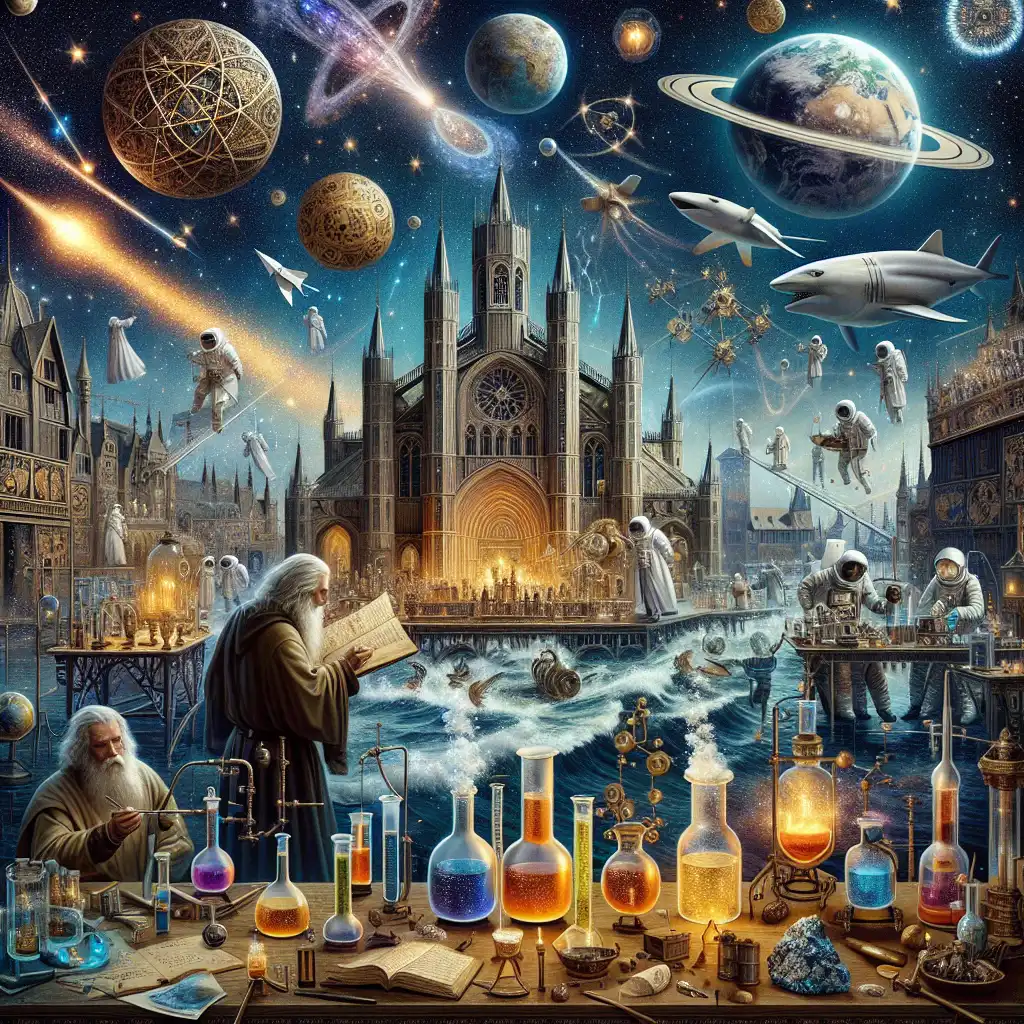Exploring the Boundaries of Human Curiosity: From Alchemy to Space Exploration
The essence of scientific inquiry lies in the relentless pursuit of knowledge through experimentation, a trait deeply rooted in our humanity. This intrinsic desire to understand the world around us has propelled countless discoveries, from the ancient practice of mapping stars to the complex endeavors of modern-day space exploration.
Throughout history, our ancestors laid the groundwork for various scientific fields. Thousands of years ago, they meticulously charted the night sky and dabbled in alchemy, the ancient precursor to modern chemistry. Even Sir Isaac Newton, renowned as the father of physics, was an ardent alchemist who documented a recipe for a key ingredient believed to create the mythical philosopher’s stone. This legendary stone was thought to possess the power to transmute any metal into silver or gold.
The Legacy of Alchemy and Its Modern-Day Relevance
Alchemy, often dismissed as pseudoscience by 18th-century chemists, surprisingly contributed significantly to the development of technology and the discovery of chemical elements still in use today. This historical practice intertwines with the realms of astronomy and chemistry, showcasing humanity’s enduring quest for knowledge.
Tycho Brahe: A Renaissance Polymath
One figure who brilliantly melded astronomy and alchemy during the Renaissance was Danish astronomer Tycho Brahe. In the 1500s, Brahe revolutionized the understanding of the cosmos by observing a supernova and proposing that the moon orbited Earth—all accomplished without the aid of telescopes.
The Secret Alchemical Work of Tycho Brahe
Within the confines of his castle, Uraniborg, which housed an observatory, Brahe also engaged in clandestine alchemical experiments. Although details of his work remain scarce, it is known that he focused on developing medicinal recipes rather than pursuing the creation of gold. Recent analyses of glass shards from his demolished alchemy lab have unveiled fascinating ingredients, including tungsten, a metal not officially described until more than 180 years after Brahe’s death.
Modern Space Exploration: Challenges and Discoveries
Humanity’s curiosity extends beyond Earth, reaching into the farthest corners of space. NASA astronauts Butch Wilmore and Suni Williams have spent over 50 days aboard the International Space Station following their historic piloting of Boeing’s Starliner spacecraft. However, their return to Earth remains uncertain due to ongoing issues with the spacecraft, including helium leaks and thruster malfunctions.
Troubleshooting the Starliner’s Technical Issues
NASA and Boeing engineers are diligently working to identify the root causes of these anomalies. Ground tests have been conducted for weeks to replicate and understand the issues. Mark Nappi, Boeing’s Commercial Crew Program manager, has indicated that further tests over the weekend are expected to provide comprehensive insights into the problems.
SpaceX’s Continued Endeavors
Meanwhile, SpaceX has received clearance to resume launches with its Falcon 9 rocket, despite a recent mission-ending failure. Once the Starliner mission concludes, SpaceX will transport a team of astronauts for NASA’s Crew-9 mission to the space station.
Unveiling the Mysteries of the Deep Sea
Scientific exploration is not limited to the skies; the depths of the ocean harbor their own enigmas. Marine scientists have uncovered a remarkable phenomenon: oxygen production without photosynthesis occurring more than 13,000 feet below the ocean’s surface. This discovery could offer valuable clues about the origins of life on Earth.
Discovering “Dark” Oxygen in the Deep Sea
A decade ago, Andrew Sweetman, a professor at the Scottish Association for Marine Science, detected unexpected oxygen levels in the Pacific Ocean using sensor equipment. Initially suspecting a malfunction, Sweetman has since led research suggesting that “dark” oxygen may be generated by potato-sized metallic nodules acting as “geobatteries” within the deep-sea ecosystem.
The Impact of Human Activities on Marine Life
Human activities continue to impact marine life, as evidenced by footage captured from a camera attached to an endangered shark. This footage revealed the shocking moment a boat struck the marine animal, highlighting the prevalence of boat strikes in ocean habitats.
The Plight of the Basking Shark
The footage, recorded around the Blasket Islands off the coast of Ireland, shows a 23-foot basking shark sustaining a large scratch and paint streaks from the collision. Researchers are uncertain whether the shark survived, but the incident underscores the need for greater protection of endangered marine species.
Cocaine Contamination in Marine Ecosystems
In a separate study, scientists discovered cocaine in sharks off the coast of Brazil, marking the first instance of the drug being detected in free-ranging sharks. This finding raises concerns about the broader implications of pollution on marine ecosystems.
Martian Discoveries: Clues to Ancient Life
The Perseverance rover, tirelessly exploring Mars, has made a potentially groundbreaking discovery that could indicate the red planet once harbored microbial life. By examining a rock dubbed Cheyava Falls, the rover detected chemical signatures and structures that might have been formed by ancient life during a time when water was present on Mars.
Analyzing Martian Rocks for Signs of Life
David Flannery, an astrobiologist on the Perseverance science team, emphasized the significance of these findings. “These spots are a big surprise,” Flannery remarked, noting that on Earth, similar features in rocks are often associated with fossilized microbial life.
Intriguing Scientific Discoveries
Scientific exploration continues to yield surprising and fascinating findings across various fields:
- Komodo Dragons: The world’s largest lizards have iron-tipped teeth with serrated edges stained orange, aiding them in tearing apart their prey, according to new research.
- Chandra X-ray Observatory: Celebrating 25 years in space, NASA released 25 new images showcasing the glowing beauty of the cosmos. However, budget cuts could threaten the continuation of this mission.
- Blushing Chickens: Domestic hens have been observed to blush, expressing fear or excitement, as documented by researchers on a French farm.
Frequently Asked Questions
What is the significance of Tycho Brahe’s alchemical work?
Tycho Brahe’s alchemical experiments, though secretive, contributed to the development of medicinal recipes and the discovery of elements like tungsten, which were not officially recognized until centuries later.
How are NASA and Boeing addressing the issues with the Starliner spacecraft?
NASA and Boeing engineers are conducting ground tests to replicate and understand the anomalies experienced during the Starliner’s journey. These efforts aim to identify the root causes and implement necessary fixes.
What is “dark” oxygen, and why is it significant?
“Dark” oxygen refers to oxygen produced without photosynthesis, discovered in the deep sea. This phenomenon, potentially caused by metallic nodules acting as “geobatteries,” could provide insights into the origins of life on Earth.
How does human activity impact marine life, particularly sharks?
Human activities, such as boating, pose significant threats to marine life. Footage of a boat striking an endangered basking shark highlights the need for greater protection of these species.
What has the Perseverance rover discovered on Mars?
The Perseverance rover has detected chemical signatures and structures in Martian rocks that may suggest the presence of ancient microbial life when water flowed on Mars billions of years ago.
Conclusion
The enduring human spirit of curiosity and exploration has driven remarkable scientific discoveries across various domains. From the alchemical experiments of Tycho Brahe to the cutting-edge research conducted by modern astronauts and marine scientists, each finding contributes to a greater understanding of our world and beyond. As we continue to push the boundaries of knowledge, the importance of protecting our planet and its diverse ecosystems becomes ever more apparent. By safeguarding our natural environment and supporting scientific endeavors, we pave the way for future generations to uncover the mysteries of the universe.
















